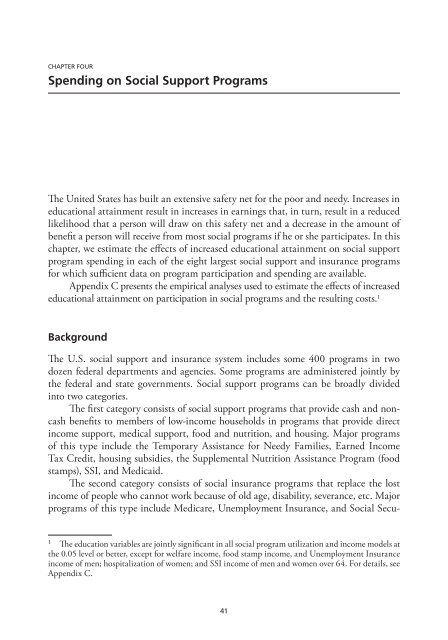The Benefits to Taxpayers from Increases in Students - RAND ...
The Benefits to Taxpayers from Increases in Students - RAND ...
The Benefits to Taxpayers from Increases in Students - RAND ...
Create successful ePaper yourself
Turn your PDF publications into a flip-book with our unique Google optimized e-Paper software.
Chapter Four<br />
Spend<strong>in</strong>g on Social Support Programs<br />
<strong>The</strong> United States has built an extensive safety net for the poor and needy. <strong>Increases</strong> <strong>in</strong><br />
educational atta<strong>in</strong>ment result <strong>in</strong> <strong>in</strong>creases <strong>in</strong> earn<strong>in</strong>gs that, <strong>in</strong> turn, result <strong>in</strong> a reduced<br />
likelihood that a person will draw on this safety net and a decrease <strong>in</strong> the amount of<br />
benefit a person will receive <strong>from</strong> most social programs if he or she participates. In this<br />
chapter, we estimate the effects of <strong>in</strong>creased educational atta<strong>in</strong>ment on social support<br />
program spend<strong>in</strong>g <strong>in</strong> each of the eight largest social support and <strong>in</strong>surance programs<br />
for which sufficient data on program participation and spend<strong>in</strong>g are available.<br />
Appendix C presents the empirical analyses used <strong>to</strong> estimate the effects of <strong>in</strong>creased<br />
educational atta<strong>in</strong>ment on participation <strong>in</strong> social programs and the result<strong>in</strong>g costs. 1<br />
Background<br />
<strong>The</strong> U.S. social support and <strong>in</strong>surance system <strong>in</strong>cludes some 400 programs <strong>in</strong> two<br />
dozen federal departments and agencies. Some programs are adm<strong>in</strong>istered jo<strong>in</strong>tly by<br />
the federal and state governments. Social support programs can be broadly divided<br />
<strong>in</strong><strong>to</strong> two categories.<br />
<strong>The</strong> first category consists of social support programs that provide cash and noncash<br />
benefits <strong>to</strong> members of low-<strong>in</strong>come households <strong>in</strong> programs that provide direct<br />
<strong>in</strong>come support, medical support, food and nutrition, and hous<strong>in</strong>g. Major programs<br />
of this type <strong>in</strong>clude the Temporary Assistance for Needy Families, Earned Income<br />
Tax Credit, hous<strong>in</strong>g subsidies, the Supplemental Nutrition Assistance Program (food<br />
stamps), SSI, and Medicaid.<br />
<strong>The</strong> second category consists of social <strong>in</strong>surance programs that replace the lost<br />
<strong>in</strong>come of people who cannot work because of old age, disability, severance, etc. Major<br />
programs of this type <strong>in</strong>clude Medicare, Unemployment Insurance, and Social Secu-<br />
1<br />
<strong>The</strong> education variables are jo<strong>in</strong>tly significant <strong>in</strong> all social program utilization and <strong>in</strong>come models at<br />
the 0.05 level or better, except for welfare <strong>in</strong>come, food stamp <strong>in</strong>come, and Unemployment Insurance<br />
<strong>in</strong>come of men; hospitalization of women; and SSI <strong>in</strong>come of men and women over 64. For details, see<br />
Appendix C.<br />
41
















